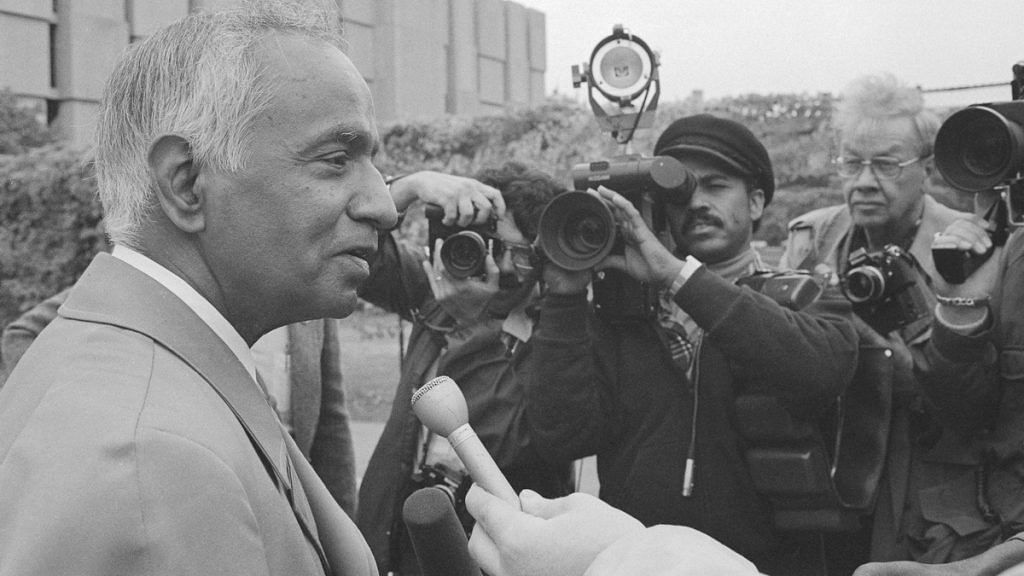Chandrasekhar’s work on stars and black holes yielded several honours but he struggled with opposition from senior scientists to ‘Chandrasekhar limit’.
Indian-origin astrophysicist and Nobel prize winner Subrahmanyan Chandrasekhar left a huge legacy in the world of science through his work on theoretical structure and evolution of stars, and establishing the mathematical ‘Chandrasekhar limit’.
His work on black holes, white dwarfs and stars was so immense that the flagship Chandra X-ray observatory was named after him as a token of honour by the National Aeronautics and Space Administration (NASA) in 1999.
On his 108th birth anniversary, here’s a look back at one of the foremost astrophysicists of his time.
Early life
Chandrasekhar, or fondly called Chandra, was born into a well-educated Tamil family in Lahore (present day Pakistan) on 19 October 1910. His father C. Subrahmanyan Ayyar was the deputy auditor general of the Northwestern Railways and his mother was a translator.
“My mother, Sita (neé Balakrishnan) was a woman of high intellectual attainments (she translated into Tamil, for example, Henrik Ibsen’s A Doll House), was passionately devoted to her children, and was intensely ambitious for them,” wrote Chandrasekhar in his autobiography.
Also read: Mumbai physicist who devised mathematical way to define Einstein prediction wins top prize
He was home-schooled till the age of 12 and developed a keen interest in physics, greatly inspired by Isaac Newton. Chandrasekhar was the nephew of Nobel Prize winning Indian physicist C.V. Raman.
In 1918, Chandrasekhar and his family moved to Madras (now Chennai) where he attended Hindu High School. In 1930, he graduated with a B.Sc Hons degree in Physics from Presidency College, where he wrote his first paper — The Compton Scattering and the New Statistics.
Chandrasekhar then received a scholarship to study at the Cambridge University in England under professor Ralph Fowler and received his PhD in 1933. Chandrasekhar presented two papers during his term to London’s Royal Astronomical Society.
Academic career
One of his Cambridge papers explained that stars which were more massive than the sun would explode or form black hole as they died.
He also proved that there was an upper limit to the mass of a white dwarf (remnant of stars like sun), which came to be known as the ‘Chandrasekhar limit’.
However, not all was rosy for Chandrasekhar’s academic life at Cambridge. The ‘Chandrasekhar limit’ was opposed by renowned physicists, including Sir Arthur Eddington, who refused that a star could collapse down to a point.
Eddington, whom Chandrasekhar looked up to, was very critical of him, which left a long-term impact on him. He felt that Eddington’s mockery towards him was racially motivated, and was frustrated that other European scholars did not show open solidarity with him due to the high stature of Eddington in the field.
So he decided to leave Europe and accepted the offer of assistant professorship at University of Chicago in US in 1937, where he spent the rest of his career. He spent a brief year at the Institute of Theoretical Physics in Copenhagen, where he worked with Niels Bohr, the Nobel Prize winning Danish physicist.
He became a naturalised US citizen in 1953.
Also read: Nobel winners Allison & Honjo have helped reverse cancer completely in some patients
Honours
Chandrasekhar wrote extensively about his field of study and published 10 books.
Besides writing about evolution of stars, Chandrasekhar also focused on the theory of radiative transfer and the quantum theory of negative ion of Hydrogen. He also served as the editor of the reputed Astrophysical Journal for 19 years.
He was elected fellow of the Royal Society in 1944 and became an honorary member of the International Academy of Science in 1988.
Through his life, Chandrasekhar won numerous awards for his work, including the Nobel Prize in Physics in 1983 for his contribution in formulating theories on the evolution of stars. He was awarded “for his theoretical studies of the physical processes of importance to the structure and evolution of the stars.”
He was, however, dissatisfied with the fact that the Nobel Prize citation only mentioned his earlier works and not the breakthroughs he made later in his life.
Chandrasekhar succumbed to heart failure on 21 August 1995 and died at the age of 84. He was survived by his wife Lalitha who went on to live till the age of 102 and passed away in 2013.
